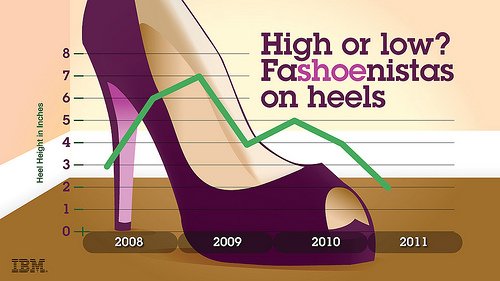Indeed, according to a recent IBM study, Chief Marketing Officers around the world recognize the need to embrace social media in their business - but only a small minority of them actually factor information from blogs and other forms of social media into their strategic decisions.
"Usually, in an economic downturn, heels go up and stay up - as consumers turn to more flamboyant fashions as a means of fantasy and escape," said Dr. Trevor Davis, a consumer products expert with IBM Global Business Services. "This time, something different is happening -- perhaps a mood of long term austerity is evolving among consumers sparking a desire to reduce ostentation in everyday settings."
A look back at the last 100 years of shoe fashion trends reveals that heel heights soared during the most prominent recessions in U.S. history. Low-heeled flapper shoes in the 1920s were replaced with high-heel pumps and platforms during the Great Depression. Platforms were again revived during the 1970s oil crisis, reversing the preference for low-heeled sandals in the late 1960s. And the low, thick heels of the 1990s "grunge" period gave way to "Sex and the City"-inspired stilettos following the dot-com bust at the turn of the century.
In a potential deviation from the long-term trend, Davis continued, an analysis of the last four years of social media showed that discussions of increasing heel height peaked towards the end of 2009, and declined after that. For example, key trend-watching bloggers between 2008 and 2009 wrote consistently about heels from five to eight inches, but by mid 2011 they were writing about the return of the kitten heel and the perfect flat from Jimmy Choo and Louboutin. This is not to say that the sky-high heels have gone, rather that, as the economic downturn has wore on, they are discussed as glamwear and not for the office or shopping trip, Davis said.
While heels on women's shoes are still high - as a visit to any shoe store will confirm -- the IBM analysis points to a change in trend. This datacould be used by shoe manufacturers and retailers looking for insight into the kind of shoes to, respectively, manufacture and sell in the coming season.
Here's how the analysis was conducted: first, IBM used special analytics software to search billions of social media posts to identify individuals discussing shoes. This initial category contained tens of thousands of posts. Next, the software narrowed the list down to those who are key online influencers in the area of footwear - bloggers, for example. The software relied on special algorithms that rated the popularity of these influencers by zeroing in on the ones who sit in the center of large social networks - that is, writers of blogs that many other blogs link to and which in turn link to many blogs. These bloggers aren't traditional "experts" - they don't work in the footwear industry, for example. But they are passionate footwear enthusiasts with large followings.
Finally, the software analyzed the content of the social media sites, looking specifically for discussions of shoe height.
Social media analytics in the enterprise
The IBM project illustrates how sophisticated analysis of social media could be used by manufacturers in planning future products, by retailers in choosing which products to stock, and by marketers in planning advertising campaigns.
It could also help a city or government better serve its constituents. The ability to analyze social conversation in real-time can help officials see how constituents are responding to policy decisions or how outreach could be varied across different channels to get the word out about specific events. Social media analysis could also serve as an early warning system for governments around special events and unexpected occurrences.
For example, public safety officials could use this technology as part of a rapid response system for flooding, earthquakes and other natural disasters; or to identify areas of public services delivery that need improvement.
For more information about analytics, please visit www.ibm.com/bao

